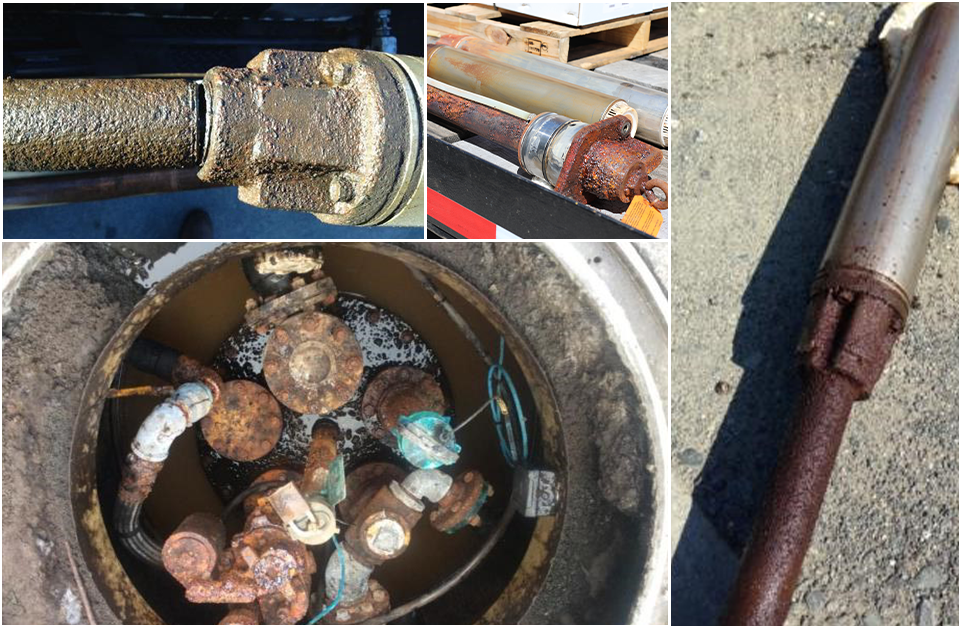Proud to be Powered by Vontier. Sharing a united vision that is driven by innovation. Find out more
Fact: Corrosion poses a significant threat to pumping infrastructure, leading to costly maintenance, operational inefficiencies, and potential environmental hazards.
Fiction: Preventing corrosion in pumping infrastructure is challenging due to the lack of effective solutions.
A UL-certified pumping infrastructure is essential for effective operations. It guarantees the incorporation of elements such as proper design, specialized coatings, and stainless steel components which enhance corrosion protection and ensure smooth functionality on site.
These elements are integrated into advanced UL-certified Red Jacket solutions, including Red Armor® Submersible Turbine Pump (STP), Biofuel Mechanical Line Leak Detector (MLLD), and special accessories like stainless steel risers, allowing them to play a crucial role in keeping a site up and running.
Let’s take a deeper dive into what that all means!
Why UL Certification Matters
UL certification is a recognized standard that assures users of the safety of a product. Utilizing a UL-certified pumping infrastructure means that your equipment has undergone rigorous testing and meets stringent safety and performance standards. In our industry, this certification is vital for reducing risks associated with fuel handling, minimizing environmental impact, and ensuring compliance with regulatory requirements.
Why the Red Armor Submersible Turbine Pump
The special design and corrosive resistant materials used in the robust, fixed speed Red Armor STP promote optimal fuel flow and dispensing.
Here’s a high-level overview of its features and benefits:
- Corrosion Resistance: The Red Armor STP was constructed specifically to withstand corrosive environments:
- Specialty coating on all cast surfaces withstands acetic acid exposure to help minimize bacteria impact and prevent pitting and deterioration over time.
- Stainless Steel construction on all exposed surfaces ensures easy maintenance for the life of the pump, including the riser, nuts, springs, screws, check valve seat, eye bolt, and check valve guide.
- UL Certifications: The Red Armor STP is UL 79A and UL 79B certified for use with the following fuel types: Ethanol concentrations up to 85%, Methanol concentrations up to 15%, Biodiesel concentrations up to 100%, Jet Fuel and AVGAS, Kerosene and Fuel Oil.
- Ease of Installation and Maintenance: The Red Armor STP features Red Jacket’s advanced packer manifold design, making it the industry’s easiest and safest STP to install and service.
- Versatile Applications: The Red Armor STP solution is available in ¾ HP to 4 HP motor configurations and fixed or Quick Set® adjustable lengths. It is best suited for environments with microbial growth in tanks (Ultra-Low Sulfur Diesel), constant moisture presence or water ingress into the sump, and known corrosion environments.
Incorporating the Red Armor STP into your pumping infrastructure significantly enhances operational reliability while safeguarding against corrosion-related failures.

Why the Biofuel Mechanical Line Leak Detector
The Red Jacket Biofuel MLLD is another critical component of a UL-certified pumping infrastructure. With the increased usage of alternative fuels, and the EPA approving year-round sales of higher ethanal blend in 8 Midwest states, the Biofuel MLLD provides protection from higher concentrations of ethanol, biodiesel, and specialty fuels.
Here’s a high-level overview of its functionalities:
- Corrosion Resistance: The Biofuel MLLD has a stainless-steel hose coupling, enhancing serviceability and corrosion protection at all levels.
- UL Certifications: The Biofuel MLLD is UL 79A and UL 79B certified for use with the following fuel types: Ethanol concentrations up to 85% and Biodiesel concentrations up to 100%.
- Ease of Installation and Maintenance: The Biofuel MLLD offers hassle-free installation with a flexible corrosion resistant, stainless-steel hose. Additionally, no special tools are required for the installation or the annual checks.
- Environmental Protection: The Biofuel MLLD meets EPA requirements in environments that experience extreme temperature changes.
Integrating the Biofuel MLLD into your pumping infrastructure enhances safety measures and reinforces a commitment to environmental stewardship.
What is the Cost of Doing Nothing
With the increased usage of biofuel blends, sites are seeing heightened signs of corrosion take hold within the sump and tank spaces. When corrosion starts to affect these spaces, it becomes harder to work on the actual equipment and it is a much longer and arduous process to take apart, service, and put back together.
What Should You Be Looking Out For
If you observe surface rust on your STP manifold, tubercles on copper lines, coffee grind type substance in your samples, these are common signs of vapor space corrosion in your sump. If you observe clogged filters, cloudy /deep brown fuel, coffee grinds in samples, and microbial 'sludge' growth, these are common signs of microbial induced corrosion in the underground storage tank.

The Bottom Line
Utilizing a UL-certified compatible pumping infrastructure is essential for modern fuel management systems. This approach not only enhances corrosion protection but also ensures smooth and efficient site operations. As the industry continues to evolve, investing in reliable and certified equipment will remain a high priority for operators to avoid site shutdowns.
